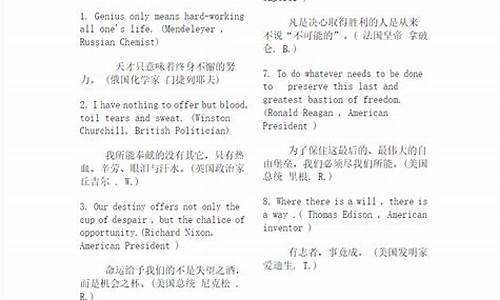下一个句子英语要加the_英语句子后面加then
1.通过这几个句子 能帮我分析系英语加the的情况 吗
2.英语中,什么情况下在比较级前要加the
3.英语句子的排列顺序 the,for,do,did,is,it,does等等,加在句子的什么地方
4.英语句子中词语前什么时候用the,什么时候用a、an?
5.I like the book 为什么要加一个the 这种句子是什么结构?

其实这样看句子的具体情况去定的。有时候或者就是可用可不用,如果句子是选择题,就要根据句子意思去选择了。
以下来自网络
定冠词the与指示代词this,that同源,有"那(这)个"的意思,但较弱,可以和一个名词连用,来表示某个或某些特定的人或东西。
1)特指双方都明白的人或物:
Take the medicine. 把药吃了。
2)上文提到过的人或事:
He bought a house. I’ve been to the house.
他买了幢房子。我去过那幢房子。
3)指世上独一物二的事物:
the sun, the sky, the moon, the earth
4)单数名词连用表示一类事物:
如:the dollar 美元;
the fox 狐狸;或与形容词或分词连用,表示一类人:the rich 富人; the living 生者。
5)用在序数词和形容词最高级,及形容词only, very, same等前面:
Where do you live? I live on the second floor. 你住在哪?我住在二层。
That’s the very thing I’ve been looking for. 那正是我要找的东西。
6)与复数名词连用,指整个群体:
They are the teachers of this school.指全体教师)
They are teachers of this school. (指部分教师)
7)表示所有,相当于物主代词,用在表示身体部位的名词前:
She caught me by the arm.. 她抓住了我的手臂。
8)用在某些由普通名词构成的国家名称、机关团体、阶级、等专有名词前:
the People’s Republic of China 中华人民共和国
the United States 美国
9)用在表示乐器的名词之前:
She plays the piano. 她会弹钢琴。
10) 用在姓氏的复数名词之前,表示一家人:
the Greens 格林一家人 (或格林夫妇)
11) 用在惯用语中:
in the day, in the morning (afternoon,evening), the day after tomorrow
the day before yesterday, the next morning,
in the sky (water,field,country)
in the dark, in the rain, in the distance,
in the middle (of), in the end,
on the whole, by the way, go to the theatre
参考资料:
英语口语语法学习口诀——定冠词用法口诀
有水无湖:海、洋、海湾、河等,都用the;单个湖不用the,(但多个湖用the);
the Red Sea, the Pacific Ocean, the Persian Gulf, the Yangtze River The
Great Lakes(五大湖);Lake Erie(伊利湖)
有球无星:地球,月亮用the;行星不用the: Mars, Venus;
有山无峰:The Huangshan Mountains(黄山);Mount Everest(珠穆朗玛峰); Mount(or Mt.) Tai(泰山).
有独无欧(偶):独一无二的,the
earth,the moon,the sun用the; 欧洲等七大洲不用the. Europe, Africa, Asia, North
America, South America, Antarctica, Oceania
有(足)族无球(运动):种族用the:the Indians(印第安人);球类运动 baseball, basketball
6.有文无章:历史性的文件用the;小说等的章节不用the The Constitution(宪法); chapter one
7.学而不专:学校放在词组的前面时用the;专有名词放在词组的前面时不用the;
The University of Fudan; Fudan University 一、定冠词的用法。 特指双熟悉,上文已提及;
世上独无二,序数最高级; 某些专有名,习语及乐器。 以上口诀归纳了用定冠词的一般情况,即:
①特指某些人或物
②谈话双方都熟悉的人或事
③上文已经提到的人或事
④世界上独一无二的事物前
⑤序数词回形容词最高级前
⑥某些专有名词前
⑦一些习惯短语(如:in the day等)中和乐器前(如:play the violin / piano)。
二、不用冠词的集中情况。 下列情况应免冠,代词限定名词前; 专有名词不可数,学科球类三餐饭; 复数名词表泛指,两节星期月份前; 颜色语种和国名,称呼习语及头衔。 以上口诀主要概括了一般应“免冠”的几种情况,即:
①名词前已有作定语用的this、that、some、any、my等限定词。
②专有名词和不可数名词前。
③表示学科的(如:maths、Chinese、physics)名词前。
④球类活动的名词前及三餐总称前。
⑤复数名词表示泛指(一类人或事)时。
⑥节日、季节、星期、月份前。
⑦表示颜色(如:It's red / yellow.)、语种(如:speak English/Japanese)和国家的非全称名词(如:We live in China. They come from America.)。
⑧在称呼或表示头衔的名词前。
⑨某些习惯短语中(如:in bed、go to school等)。 冠词用法口诀 口诀一 名词是秃子 常要戴帽子 可数名词单 需用a
或 an 辅音前用a 元音前用an 复数不可数泛指the不见 碰到代词时,冠词均不现. 口诀二(定冠词) 特指双熟悉 上文已提及
世上独无二 序数最高级 某些专有名 习语和乐器 口诀三(零冠词) 代词限定名词前 专有名词不可数 学科球类三餐饭 两季星期月份前
颜色语种和国名 称呼习语和头衔
点拨:冠词是NMET试题中出现较频繁的词性,近五年复出率高达83.3%。因而掌握冠词,尤其是定冠词的用法尤其必要。以上口诀 包括的意思有:
口诀一
①名词一般情况下不单用,常常要和冠词连用;
②表示不确指的可数名词 单数前要用不定冠词 a 或 an,确指时要用定冠词 the; 即:可数名词单数不能单独存在,必须有限定词修饰。
③如复数名词和不可数名词表示泛指或名词前有 his, these, my, some 等时就不用冠词. 口诀二 ①特指双方熟悉的事物用the
Take the medicine. 把药吃了。
②特指上文已经提到的事物用定冠词the He bought a house. I‘ve been to the house.
③世界上独一无二的事物时用the the sun, the sky, the moon, the earth
④序数词和最高级前面用the He is usually the first to come.
⑤某些由普通名词构成的国家名称、机关团体、阶级、等专有名词前用the: the People‘s Republic of China 中华人民共和国 the United States 美国
⑥乐器前和一些习惯用语中用the
She plays the piano. 她会弹钢琴 in the middle (of);in the end; on the
whole; by the way; go to the theatre
口诀三 ①代词前 或名词前有限定词时不再用冠词 such books ,this computer
②前面含有Mount Lake Cape等词的名词前一般不加冠词Mount Jolmo Lungma 珠穆朗玛峰
③学科三餐和球类名词前不用冠词 have breakfast,play chess
④季节月份星期前不用冠词 in summer on Monday
⑤表示颜色的词,语种和国家的名称前不用冠词。 Green,English,England
⑥在称呼或表示官衔,职位的名词前不加冠词; Mary,General Lee
英语中,什么情况下在比较级前要加the
第一句,因为有future做定语,所以future代替了the
第二句,因为没有定语,又要和前面的THIS(句首的那个)呼应表示指定性,所以要加the
至于连词和介词后面加不加the,只要看全句有没有指定性,被指定的名词前面是不是已经有可以代替the的定语语词。如果同时满足这两点,就不要the;如果只满足第一点,就要加the;如果连第一点也没满足,也不要加the。
英语句子的排列顺序 the,for,do,did,is,it,does等等,加在句子的什么地方
比较级最高级的时候用the。
以下是最高级的相关介绍:
最高级表示三者或三者以上的人或物进行比较时,用最高级。形容词的最高级前面要加定冠词the,副词最高级前面的the可以省略。在含有最高级的句子中,常有一个in/of/among短语来表示比较范围。屈折语一般用一定的屈折变化表示形容词的比较。普通比较称为比较级,最高比较称为最高级。
要合成形容词最高级时,只要把它们的正常词尾改成“-issimus,-issima,-issimum”就行了。举例,“latus,lata,latum”的最高级是“latissimus,latissima,latissimum”;“gravis,gravis,grave”的最高级是“gravissimus,gravissima,gravissimum”。最高级变格全部采用第一和第二变格法的词尾。
以上资料参考百度百科——最高级
英语句子中词语前什么时候用the,什么时候用a、an?
the 是冠词,加在名词的前面
for 是介词,加在名词前面也可以加在动词前面,不过动词的形式要用现在分词形式
do 是助动词,放句首构成一个问句
did 也是主动词是do的过去分词形式,和它的用法也差不多
is 是谓语动词,前面加主语后面加谓语
it 是代词,可以指代名词,一般放在句首
does是助动词是do的单三形式,用法也一样的
I like the book 为什么要加一个the 这种句子是什么结构?
不定冠词有"a和an"两种形式。"a"用在以辅音开头的词前,"an"用在以元音开头的词前。判断一个词是以元音开头还是以辅音开头,是根据读音而不是根据字母。一般情况下,开头字母是a、e、f、h、j、l、m、n、o、r、s、x前用不定冠词an。
1. 用于可数名词的单数形式前,表示"一"
There is a tiger in the zoo.
动物园里有一只老虎。
2. 表示一类人和东西
A tiger can be dangerous.
老虎可能有危害性。
3. 表示"某一个"的意思
A gentleman wants to see you.
有一位先生要见你。
4. 表示"同一"的意思
They are nearly of an age.
他们几乎同岁。
The two shirts are much of a size.
这两件衬衫大小差不多。
5. 表示"每一"的意思
We go swimming four times a week.
我们每周去游泳四次。
6. 用在作表语的单数可数名词前,表示身份、职业
My mother is a teacher.
我妈妈是教师。
7. 第一次提到的人或事物,但不特别指明是哪一个
Long long ago there was an old king who had a very beautiful daughter.
很久很久以前,有一个年老的国王,他有一个非常美丽的女儿。
8. 在英国英语中,以"h"开头的多音节词,如第一个音节不重读,其前亦可用"an"
There is a hotel near here.
这附近有一家旅馆。
9. 在such a,quite a句式中
He is quite a good actor.
他是一个相当好的演员。
Don't be in such a hurry.
不要如此匆忙。
10. 在感叹句 what...的句式中
What a pretty girl she is!
她是一个多么漂亮的女孩呀!
用在某些表示数量的词组中:
a lot of 许多
a couple of 一对
a great many 很多
a dozen 一打(但也可以用 one dozen)
a great deal of 大量 [编辑本段]定冠词的用法 1. 用以特指某(些)人或某(些)事物
This is the house where Luxun once lived.
这是鲁迅曾经住过的房子。
2. 用于指谈话双方都明确所指的人或事物
Open the door, please.
请把门打开。
3. 用以复述上文提过的人或事物(第一次提到用“a或an”,以后再次提到用“the”)
Once there lived a lion in the forest. Every day the lion asked small animals to
look for food for him.
从前森林里住着一只狮子。每天这只狮子要小动物们为他寻找食物。
4. 用在序数词和形容词最高级前
January is the first month of the year.
一月份是一年当中的第一个月。
Shanghai is the biggest city in China.
上海是中国最大的城市。
5. 表示宇宙中世界上独一无二的事物
the sun 太阳 the moon 月亮
the earth 地球 the sky 天空
the world 世界
6. 指由普通名词构成的专有名词
the West Lake 西湖 the Great Wall 长城
the United States 美国 the United Nations 联合国
定冠词的用法-2
7. 表示方向、方位
in the east 在东方 in the west 在西方
in the front 在前面 at the back 在后面
in the bottom 在底部 at the top 在顶部
on the right 在右边 on the left 在左边
8. 在海洋、江河、湖泊、山脉、海峡、海湾等地理名词前
the Pacific Ocean 太平洋 the Huanghe River 黄河
the Tainshan Mountains 天山山脉 the Taiwan Straits 台湾海峡
9. 在姓氏复数前,表示一家人
The Bakers came to see me yesterday.
贝克一家人昨天来看我。
10. 和某些形容词连用,使形容词名词化,代表一类人或物
the poor 穷人 the rich 富人
the sick 病人 the wounded 伤员
the good 好人 the beautiful 美丽的事物
11. 用在表示阶级、政党的名词前
the working class 工人阶级
the Chinese Communist Party 中国***
12. 用在the very强调句中
This is the very book I want.
这就是我想要的那本书。
13. 在the more, the more比较级的句式中
The more you drink, the more you like it.
你越喝就越爱喝。
14. 表示演奏乐器时,乐器的前面要加the
play the piano 弹钢琴
play the violin 拉小提琴
[中国乐器名词前不与冠词连用:playaerhu(二胡)]
15. 某些固定的表达法
in the morning 在早上 in the afternoon 在下午
in the evening 在晚上 go to the cinema 去看**
go to the theatre 去看戏 all the year round 一年到头
on the way to 前往...去的路上
16. the加单数可数名词可以表示一类人或事物
The horse is a useful animal.
马是一种有用的动物。
注意:像这类句子还有如下两种写法
A horse is a useful animal.
Horses are useful animals.
17.在句型“动词+sb.+介词+the+身体某一部位”中要用 the,而不
用人称代词。
take sb. by the arm 抓住某人的手臂
hit sb. in the face 打某人的脸
be red in the face 脸红
be lame in the right leg 右腿瘸 等结构中,名词前要用the [编辑本段]零冠词的用法 1. 专有名词前一般不加冠词
China 中国 Europe 欧洲
Lei Feng 雷锋 William Shakespeare 威廉·莎士比亚
2. 月份、周日、节日前一般不加冠词
January 一月份 Sunday 星期日
Christmas Day 圣诞节 Thanksgiving 感恩节
National Day 国庆节 May Day 劳动节
比较: ...on a Sunday morning.
在一个星期天的早晨... (表示某一个。)
注:民族节日前要加the 如:the Spring Festival
3. 三餐、四季前一般不加冠词
I have lunch at school.
我在学校吃午餐。
Summer is the best season for swimming.
夏天是游泳的好季节。
比较: I had a big lunch yesterday.
昨天我吃了一顿丰盛的午餐。(表示某一个)
The dinner given by Mr Smith was very nice.
史密斯先生款待的晚宴真是美味。(表示特指)
比较: I will never forget the summer we spent in Hawaii.
我永远不会忘记我们一起在夏威夷度过的那个夏天。
(表示特指)
4. 进行球类运动
play basketball 打篮球 play volleyball 打排球
play football 踢足球
5. 没有特指的物质名词
This cart is made of wood.
这辆手推车是用木头作的。
比较: The wood outside was all wet.
外面的那些木头都湿了。(表示特指)
6. 没有特指的不可数抽象名词
Time is precious.
时间是宝贵的。
比较: The time of the play was 1990s.
这个剧本的时代背景是二十世纪九十年代。(表示特指)
7. 没有特指的可数名词复数形式后。
I like tomatoes.
我喜欢西红柿。
8. 山峰
Mount Qomolangma 珠穆朗玛峰
9. 固定词组
go to school 去上学 go to bed 上床睡觉
go by train 乘火车去 go by boat 乘船去
at table 在用餐 in hospital 住院
at school 求学 in school 求学
at noon 在中午 at night 在晚上
at midnight 在半夜 in town 在城里
10. 独立结构中的名词不加冠词
A boy came in, book in hand.
一个男孩进来,手上拿着书。
11. 泛指人类
Man is mortal.
人必有一。
12. 在"kind of+名词 sort of+名词"句式中
What kind of flower is it?
这是什么花?
I like this sort of book.
我喜欢这种书。
13. 指职位、头衔的词,如king,captain,president,chairman 等。
He is (the) captain of the team.
他是球队的队长。
As (the) chairman of the committee, I declare the meeting open.
作为委员会主席,我宣布会议开始。
冠词和三餐的搭配
三餐名词单独使用时,之前通常不加冠词
三餐名词之前若加形容词时则除外:
We have breakfast at eight.
我们8点钟吃早饭。
He gave us a good breakfast.
他请我们吃了一顿丰盛的早餐。
I was invited to dinner.
他们邀请我吃饭。
I was invited to a dinner given to welcome the new ambassador.
我被邀请参加欢迎新任大使的宴会。
The Scots have porridge for breakfast.
苏格兰人早餐吃粥。
The wedding breakfast was held in her father’s house.
婚礼早宴是在她父亲家举行的。 [编辑本段]介词短语与冠词 一.、当下列名词指其“主要目的”,即与其相关在行为时,要用零冠词。
at table 在进餐
at the table 在桌子旁边
at desk 在读书
at the desk 在课桌旁
at school 在上学
at the school 在学校里
in class 在上课
in the class 在班级里面
in bed 卧床
in the bed 在床上
in prison 坐牢
in the prison (因事)在监狱
in hospital 住院
in the hospital (因事)在医院
go to school 去上学
go to the school (因事)去学校
go to bed 上床睡觉
go to the bed 在床上
go to hospital 去看病
go to the hospital 去医院
二.
take place 发生
take the place 代替
in place of 代替
in the place of 在...的地方
in case of 万一
in the case of 就...来说
out of question 毫无疑问
out of the question 完全不可能
通常使用不定冠词的短语
after a while 过了一会儿
all of a sudden 突然
as a rule 通常
as a result 结果,因此
as a matter of fact 事实上
as a whole 大体上
at a loss 不知所措
in a hurry 急忙
in a way 在某种程度上
in a word 总而言之
It’s a pity that… 令人遗憾的是…
put an end to… 结束…
come to an end 结束
come to a conclusion 得出结论
have a good time 玩得愉快
have a rest 休息一下
have a cold 感冒
have a word with 和…谈一谈
keep an eye for 对…有鉴赏力
make a living 谋生
make a fire 生火
make a fool of 愚弄
take a walk 散步 [编辑本段]冠词位置 1) 不定冠词位置
不定冠词常位于名词或名词修饰语前。注意:
a. 位于下列形容词之后: such,what,many,half,
I have never seen such an animal.
Many a man is fit for the job.
b. 当名词前的形容词被副词as, so, too, how, however, enough修饰时,不定冠词应放在形容词之后:
It is as pleasant a day as I have ever spent.
So short a time.
Too long a distance.
c. quite,rather与单数名词连用,冠词放在其后。
但当rather,quite 前仍有形容词,不定冠词放其前后均可。如:quite a lot
d. 在as,though 引导的让步状语从句中,当标语为形容词修饰的名词时,不定冠词放形容词后:
Brave a man though he is,he trembles at the sight of snakes. 他尽管勇敢,可见到蛇还是发抖。
当名词被比较级形容词修饰时,不定冠词通常置于比较级形容词之后。
2) 定冠词位置
定冠词通常位于名词或名词修饰语前,但放在all, both,double,half,twice,three times等词之后,名词之前。
All the students in the class went out. 班里的所有学生都出去了。 [编辑本段]冠词与形容词+名词结构 1) 两个形容词都有冠词,表示两个不同东西。
He raises a black and a white cat. 他养了一只黑猫和一只白猫。
The black and the white cats are hers. 这只黑猫和白猫都是他的。
2) 如后一个形容词无冠词,则指一物。
He raises a black and white cat. 他养了一只花猫。 [编辑本段]冠词的使用错误 大家除了掌握使用冠词的基本规则外,还应不拘泥于规则,注意冠词的活用:
1.表示世界上独一无二的事物的名词前一般加定冠词the; 但如果名词前有修饰语,也可能用不定冠词a,an。
the world, a peaceful world
the moon, a bright moon
2. 表示一日三餐的名词前面一般不用冠词,但前面如果有了定语修饰,也可能用不定冠词a, an。
Have you had supper?
We had a wonderful supper.
3. 表示乐器的名词前一般用定冠词the, 但前面如果出现定语修饰,也可能用不定冠词a, an。
He starts his day by playing the violin.
He is playing a borrowed violin.
4. 介词与表示交通工具的名词连用表示笼统的方式,前面一般不用冠词,但如果名词的前面出现了修饰语,前面需加冠词。
He went to the station by car.
He went to the station in a black car.
5. 表示语言的名词前一般不用冠词,但后面如果出现language一词,前面需加定冠词the。
English=the English language French=the French language
6. turn用作系动词时,后面作表语的单数名词前不用冠词。
He turned writer many years later.(=He became a writer many years later.) [编辑本段]冠词口诀 冠词分为定冠、不定冠,
不定冠词a和an,“—”的含义表泛指
表示特指要用the,次序、方位、最高级
世上物体独一个,人或事物再次提
以下情况冠词免,学科球类三顿饭
名词复数表泛指,季节星期月份前
这句话是“主 谓 宾 ”结构:I 是主语,like是谓语动词,the book 是宾语.
book前面加the 是特指这本书,在英语里,单数可数名词前面不能光秃秃的用.
a book 泛指一本书(不确定哪本,只要是书)
the book 特指这本书.
声明:本站所有文章资源内容,如无特殊说明或标注,均为采集网络资源。如若本站内容侵犯了原著者的合法权益,可联系本站删除。












